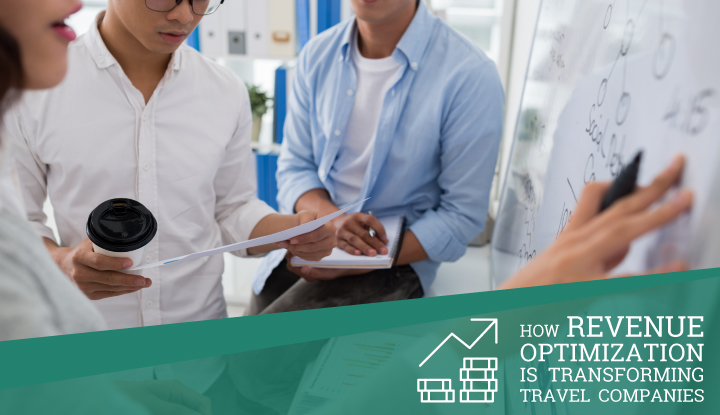By Jared Hall
Jared Hall shares his expertise on how to make the most of your revenue strategy with technology and optimization.
Jared has been delivering innovative technology solutions to the travel industry for almost 15 years. As the director of the Revenue Optimization product management team at Sabre he is focused on helping travel agencies execute on their revenue strategies.
“The Importance of a Revenue Strategy” made the case that a thoughtfully devised, data-driven approach can bolster long-term competitiveness by repeatedly uncovering ways to earn more revenue. The challenge and opportunity boil down to some fundamental travel industry realities: Margins are thin, competition is fierce and optimizing revenue is key if you don’t want to settle for less than your performance potential. And yes, it’s more than you might think.
Putting theory into practice
But what does a revenue strategy actually look like in practice? It starts by first committing to improve and then investing in the tools and technology necessary to understand and track your performance in real time. Just knowing where you are can uncover straightforward opportunities to capture significant revenue.
We would like to introduce exactly what we mean by revenue optimization. First, this is what it’s not: It’s not a one-time, simple fix. Rather, it’s a mindset and cycle that begins with using the power of data to identify areas where you can increase revenue. Once identified, optimization requires quick action to take advantage of those opportunities through smart retailing.
We say that optimization is a cycle and a mindset because it’s a process that doesn’t end. It begins with seizing additional revenue. These additional revenue opportunities are discovered by data-driven insights and captured by fast action.
Optimization is the process of reviewing previous actions to determine the negative or positive impacts that occurred and then using that information to improve existing strategies and implement new ones. This never ends and it is what ensures that your efforts continuously improve.
This has traditionally been a challenging process because it has involved manually collecting and analysing data from a variety of sources and making business decisions without a single source of truth, or an effective way to implement retailing actions at scale.
Example of process in action
Here’s an example of how optimization could work: Let’s say a travel agency has a carrier commission contract agreement that provides a payout of 2 percent of sales if an overall revenue target of $5 million in tickets is achieved over the course of a calendar year.
With the right tools to monitor its progress toward the $5 million, the agency can make small changes to ensure that it hits that goal, such as, internally increasing the visibility of products that count toward the revenue target or running promotional campaigns with prospective clients.
Revenue optimization strategies can be implemented in ways that support consistent and positive customer experiences while still benefitting your business.
Another strategy available to agencies selling large volumes of airline content is to negotiate private fares. To do this successfully, better insight into past performance can translate to more favourable negotiated rates.
Those who obtain negotiated fares can capture more value from what they sell through markups. Instead of guessing or leaving it to chance, agencies can use the right data to drive smarter retailing decisions.
For instance, how much should negotiated fares be marked up? How does the markup change from market to market? How do you keep track of all your negotiated fares and how you’re marking them up? Which of your fares are most profitable? Which convert the best? Answers to these questions come from having data that can be analysed and acted on quickly.
Optimizing revenue continuously
Revenue optimization can involve actions that will either not be noticed by a traveller or will be regarded as a benefit. For instance, having a technology solution that allows agents to focus on each customer experience can boost revenue.
How?
Well, many consultants manually claim supplier commissions when issuing airline tickets, taking an average of 10 minutes per commissionable ticket. Automating the commissions claim process eliminates this task from the consultant workflow, so the consultant can devote their energy and time to serving the customer and offering ways to enhance their trip — like up-selling offers that can also drive additional revenue. This is just one use case of many.
It’s also worth remembering that even the best revenue strategy is in constant need of a refresh.
Making room for growth
Successful travel agencies, by definition, maximise their revenue consistently and deliver products that bring benefits to themselves and to their existing customers. Seizing additional revenue possibilities can also provide agencies with the necessary resources to grow. Agencies that execute their revenue strategy successfully can then turn their attention to finding and attracting new customers, who can provide even more revenue.
Data-driven insights are forever uncovering new opportunities to drive revenue — insights that must lead to adjustments in order to be beneficial. The best travel companies will adopt the revenue optimization mindset and cycle, constantly reevaluating their operations and making changes along the way to improve financial performance.
Making revenue optimization happen takes technology and know-how. No matter the size of your business or the stage in which your strategy is — developing or mature — Sabre’s experts can help.
Our blog series detailing the fundamentals of revenue optimization and the tools available to help you succeed will continue over the next months —stay tuned. Our technology suite is growing, and we want to help your business grow with us.
